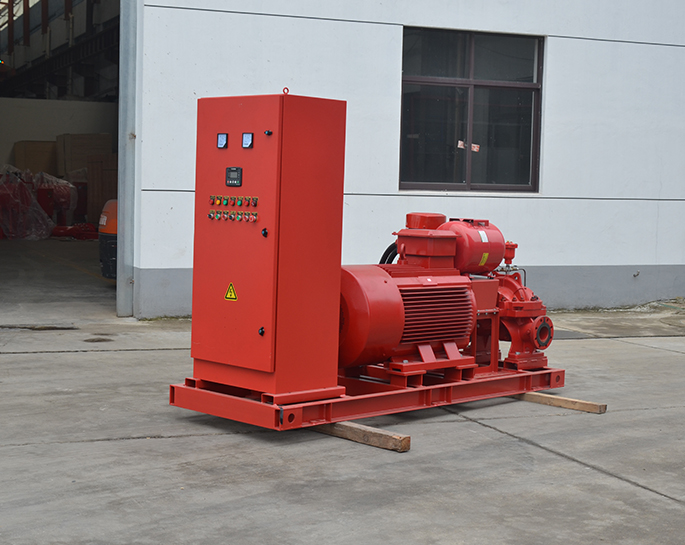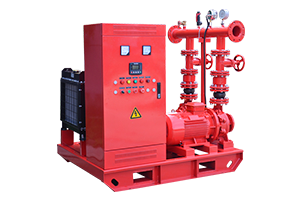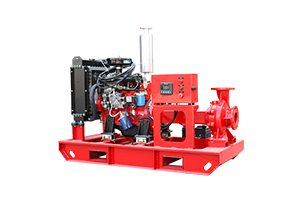What maintenance is required for an electric fire pump?
May 30, 2024
Share:
Maintaining an electric fire pump is critical to ensure its reliability and proper operation in case of an emergency. Regular maintenance tasks can be categorized into routine inspections, periodic tests, and scheduled services. Here's a comprehensive guide to electric fire pump maintenance:
### Routine Inspections (Weekly)
1. **Visual Inspection:**
- Check for any visible leaks in the pump casing, pipes, and fittings.
- Ensure the pump and its surroundings are clean and free of debris.
- Inspect electrical connections for any signs of wear or damage.
2. **Check Pump House Conditions:**
- Ensure adequate ventilation and temperature control.
- Verify that the pump house is dry and free from obstructions.
3. **Check Gauges and Indicators:**
- Ensure pressure gauges, flow meters, and other indicators are functioning correctly.
- Verify that the suction and discharge pressures are within normal operating ranges.
4. **Alarm Systems:**
- Test alarm systems and ensure they are functioning properly.
### Periodic Tests (Monthly/Quarterly)
1. **Manual Start Test:**
- Start the pump manually and let it run for a short period (usually about 30 minutes) to ensure it operates correctly.
- Check the motor and pump for unusual noises, vibrations, or overheating.
2. **Flow Test:**
- Conduct a flow test to ensure the pump delivers the required flow and pressure.
- Measure and record the discharge pressure and flow rate to compare with the pump's specifications.
3. **Electrical System Inspection:**
- Inspect and test the motor controller, circuit breakers, and power supply.
- Ensure all electrical connections are secure and free from corrosion.
### Scheduled Services (Annually)
1. **Full Operational Test:**
- Conduct a full operational test under load to simulate actual emergency conditions.
- Ensure the pump operates at its rated capacity and pressure.
2. **Pump and Motor Inspection:**
- Disassemble and inspect the pump impeller, casing, and wear rings for signs of wear or damage.
- Inspect and lubricate motor bearings as required by the manufacturer.
3. **Electrical System Maintenance:**
- Perform insulation resistance tests on the motor windings.
- Verify the operation of all electrical components, including controllers, relays, and switches.
4. **Battery System Check (if applicable):**
- Inspect and test the battery system, including the charger, for proper operation.
- Ensure batteries are in good condition and replace if necessary.
5. **System Calibration:**
- Calibrate all gauges, meters, and sensors to ensure accurate readings.
- Check and adjust pressure relief valves and other safety devices.
6. **Documentation and Records:**
- Maintain detailed records of all inspections, tests, and maintenance activities.
- Review maintenance logs to identify and address any recurring issues.
### General Best Practices
- **Follow Manufacturer’s Recommendations:**
- Adhere to the specific maintenance guidelines provided by the pump and motor manufacturers.
- **Training:**
- Ensure maintenance personnel are trained and knowledgeable about the specific fire pump system.
- **Emergency Procedures:**
- Regularly review and update emergency procedures and ensure all personnel are familiar with them.
By following these maintenance guidelines, you can help ensure that your electric fire pump remains in good working condition and is ready to perform effectively in an emergency situation.

### Routine Inspections (Weekly)
1. **Visual Inspection:**
- Check for any visible leaks in the pump casing, pipes, and fittings.
- Ensure the pump and its surroundings are clean and free of debris.
- Inspect electrical connections for any signs of wear or damage.
2. **Check Pump House Conditions:**
- Ensure adequate ventilation and temperature control.
- Verify that the pump house is dry and free from obstructions.
3. **Check Gauges and Indicators:**
- Ensure pressure gauges, flow meters, and other indicators are functioning correctly.
- Verify that the suction and discharge pressures are within normal operating ranges.
4. **Alarm Systems:**
- Test alarm systems and ensure they are functioning properly.
### Periodic Tests (Monthly/Quarterly)
1. **Manual Start Test:**
- Start the pump manually and let it run for a short period (usually about 30 minutes) to ensure it operates correctly.
- Check the motor and pump for unusual noises, vibrations, or overheating.
2. **Flow Test:**
- Conduct a flow test to ensure the pump delivers the required flow and pressure.
- Measure and record the discharge pressure and flow rate to compare with the pump's specifications.
3. **Electrical System Inspection:**
- Inspect and test the motor controller, circuit breakers, and power supply.
- Ensure all electrical connections are secure and free from corrosion.
### Scheduled Services (Annually)
1. **Full Operational Test:**
- Conduct a full operational test under load to simulate actual emergency conditions.
- Ensure the pump operates at its rated capacity and pressure.
2. **Pump and Motor Inspection:**
- Disassemble and inspect the pump impeller, casing, and wear rings for signs of wear or damage.
- Inspect and lubricate motor bearings as required by the manufacturer.
3. **Electrical System Maintenance:**
- Perform insulation resistance tests on the motor windings.
- Verify the operation of all electrical components, including controllers, relays, and switches.
4. **Battery System Check (if applicable):**
- Inspect and test the battery system, including the charger, for proper operation.
- Ensure batteries are in good condition and replace if necessary.
5. **System Calibration:**
- Calibrate all gauges, meters, and sensors to ensure accurate readings.
- Check and adjust pressure relief valves and other safety devices.
6. **Documentation and Records:**
- Maintain detailed records of all inspections, tests, and maintenance activities.
- Review maintenance logs to identify and address any recurring issues.
### General Best Practices
- **Follow Manufacturer’s Recommendations:**
- Adhere to the specific maintenance guidelines provided by the pump and motor manufacturers.
- **Training:**
- Ensure maintenance personnel are trained and knowledgeable about the specific fire pump system.
- **Emergency Procedures:**
- Regularly review and update emergency procedures and ensure all personnel are familiar with them.
By following these maintenance guidelines, you can help ensure that your electric fire pump remains in good working condition and is ready to perform effectively in an emergency situation.







